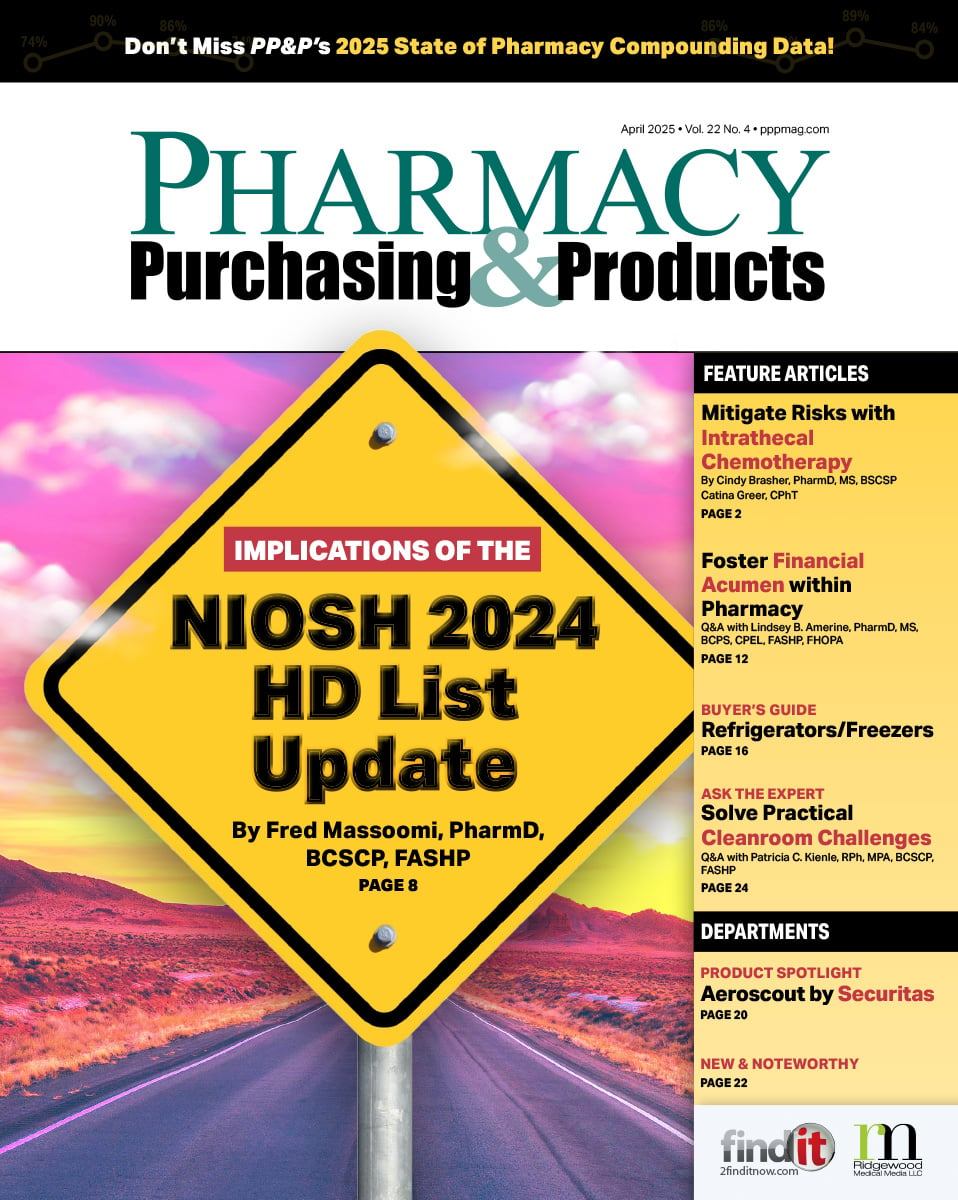- Show Menu
- Contact Us
- FAQs
- Reader Service
- Survey Data
- Survey Winners
- Testimonials
- Upcoming Events
- Webinars
- White Papers
Comparison of USP <800> Gap Analysis Tools
The publication of the United States Pharmacopeia (USP) Chapter <800> in February, 2016 establishes new standards for handling hazardous drugs (HDs) in health care settings.1 The primary focus of the chapter is ensuring employee and patient safety through proper receipt, storage, compounding, administration, and disposal of HDs. Many health care organizations will need to institute facility upgrades and establish new institutional policies and procedures (P&Ps) to achieve compliance with the regulations outlined in USP <800> by the enforcement deadline of July 1, 2018.
A comprehensive understanding of an organization’s USP <800> compliance gaps is essential to developing a plan to achieve full compliance. A recent article published in Pharmacy Purchasing & Products describes the development of a USP <800> compliance strategy, complete with a gap analysis tool.2 The six key steps for creating a USP <800> compliance plan specific to an organization include:
- Establishing an HD List
- Conducting a Hazardous Risk Assessment
- Implementing Needed Facilities Design/Redesign
- Creating and/or Updating P&Ps
- Establishing a Staff Training Plan
- Monitoring Staff Compliance and Health
The first two steps emphasize performing a gap analysis, which is critical to identify and correct areas of noncompliance with the chapter. Several gap analysis tools are available, including three reviewed in this article: Joint Commission Resources’ HazMedSafety.com,3 CriticalPoint’s 800gaptool.com,4 and CompoundingToday.com’s USP <800> Gap Analysis Tool.5
Joint Commission Resources’ HazMedSafety.com3
Joint Commission Resources, in collaboration with Becton Dickinson (BD), offers HazMedSafety.com, a self-assessment tool to determine an organization’s readiness for USP <800>-compliant HD handling. The tool was developed based on a comprehensive list of guidelines for the safe handling of HDs, including: USP <800>,1 The Joint Commission 2016 Comprehensive Accreditation Manual,6 the American Society of Health-System Pharmacists’ Guidelines on Handling HDs,7 the Oncology Nursing Society’s Safe Handling of HDs,8 CMS Condition of Participation §482.11(a),9 Occupational Safety and Health Administration’s HAZCOM 1994 Program Guidance,10 and the National Institute for Occupational Safety and Health’s list of HDs.11
Upon visiting HazMedSafety.com, the user is prompted to create an account and provide background information indicating how HDs are used within the organization. These tasks include receiving, unpacking, storing, compounding, dispensing, administering, disposing, and wasting HDs. After completing this background section, the user must complete 10 survey sections:
- Organizational Planning
- Facilities: Receipt and Storage
- Facilities: Compounding
- Personal Protective Equipment (PPE)
- Administration
- Deactivation/Decontamination/Cleaning/Disinfection of HDs
- Spill Control
- Disposal
- Medical Surveillance
- Environmental Monitoring
Each section contains a list of yes/no questions. Users familiar with their current HD handling practices will only require a few minutes to complete each section. Upon completion of the 10 sections, users continue to the survey dashboard, which shows survey progress, contains links to edit any of the completed survey sections, and includes a link to a detailed consultative survey report. The survey report provides consultative notes for each section, an overall USP <800>-compliance percentage, and a breakdown of the areas where the organization is noncompliant. A list of recommendations for achieving compliance with each noncompliant area is provided. The recommendations may offer additional resources for organizations that are noncompliant in certain aspects of <800>.
Overall, HazMedSafety.com is an aesthetically pleasing, user-friendly online self-assessment tool. Completion of the survey provides detailed compliance reports for organizations seeking to assess their gaps in handling HDs.
CriticalPoint, LLC’s 800gaptool.com4
CriticalPoint, LLC offers 800gaptool.com as part of the 2017 USP <800> Compliance Study. The results of the 2017 compliance study report have been published12; nevertheless, CriticalPoint continues to offer free use of the gap analysis tool, which includes a how-to guide that users are encouraged to read before completing the self-assessment. The how-to guide estimates it will take organizations approximately 1-2 hours to complete the survey.
The user creates an account on the site and is then directed to the main self-assessment tool page, which contains links to 53 domains to complete. The user provides demographic information, as well as compounding information, including locations within the organization that compound, the number of preparations compounded per week, and the organization’s compounding survey history (eg, accreditation organization and/or the board of pharmacy). The next domain focuses on general compounding; the user’s answers to these questions direct the survey across the remaining 51 domains, which include both USP <797> and USP <800> requirements.
The general compounding section comprises questions pertaining to the types of compounding performed within the organization and what environmental measures exist within each compounding area (ie, primary/secondary engineering controls, automated compounding devices). After answering the questions in this section, the user can choose to limit the gap analysis only to USP <800> requirements, or to include questions pertaining to USP <797> compliance as well. Limiting the gap analysis to only USP <800> requirements reduces the number of domains to complete from 51 to 15.
Completing each domain leads the user back to the survey home page, which includes a listing of each domain and its completion status. PDF compliance reports for each domain and for the full USP <800>-compliance report are available for download. The full report details which questions triggered noncompliance, as well as an action plan for becoming compliant in each of these areas.
CriticalPoint’s self-assessment tool is well-designed to help organizations gain a better understanding of their compliance gaps and put an action plan in place to address these issues. In addition, the tool provides users the option of performing a gap analysis for both USP <797> and USP <800>.
CompoundingToday.com’s USP <800> Gap Analysis Survey5
The International Journal of Pharmaceutical Compounding’s USP <800> Gap Analysis Survey is published in the compliance section of its Web site, CompoundingToday.com (https://compoundingtoday.com/Compliance/USPGap.cfm). Gap analysis tools for USP <795> and USP <797> also are available. Each tool is available as a downloadable PDF file for printing or an Excel file with survey fields that can be electronically edited.
This gap analysis survey differs from the previous two presented in that it is offline and does not offer interactive reporting based on user input. Instead, it presents USP <800> compliance criteria in rows, complete with columns for listing current status, the plan for becoming compliant, which staff member is responsible for the compliance plan, and a target date for completion. The survey lists criteria for 16 compliance areas related to corresponding sections within USP <800>. Following completion of the assessment, the tool encourages users to obtain full copies of the USP chapters.
The USP <800>-gap analysis survey offered by CompoundingToday.com is a basic instrument that assists organizations in planning steps to become compliant with each chapter domain. Organizations that already have a thorough understanding of USP <800> may find this tool easy to use, particularly if the organization is simply looking to develop an action plan for compliance.
Conclusion
These gap analysis tools are important resources for helping organizations gain a comprehensive understanding of their USP <800> deficits. Identifying existing gaps is the first step to developing an action plan to become compliant with the chapter. Knowledge of USP <800> compliance gaps will position organizations for success as they continue on the journey to ensure safe handling of HDs.
References
- United States Pharmacopeial Convention, Inc. <800> Hazardous Drugs—Handling in Healthcare Settings. United States Pharmacopeia 39–National Formulary 34. Rockville, MD: US Pharmacopeial Convention, Inc, 2016.
- Aguero D, Marge K. Developing a USP <800> compliance gap analysis. Pharm Purch Prod. 2017;14(1):10-12.
- Mansur J, Kienle P, Kastango E. Self-Assessment of Safe Handling Practices for Hazardous Drugs Survey. Joint Commission Resources. https://hazmedsafety.com/. Accessed March 1, 2017.
- Kastango E, Douglas K. The 2017 USP <800> Compliance Study: A National Study of Hazardous Drug Compounding Practices Gap Analysis Tool. CriticalPoint, LLC. www.800gaptool.com. Accessed March 1, 2017.
- USP <800> Hazardous Drugs—Handling in Healthcare Settings Gap Analysis Survey. Int J Pharm Compounding. https://compoundingtoday.com/Compliance/USPGap.cfm. Accessed March 1, 2017.
- The Joint Commission. 2016 Comprehensive Accreditation Manual for Hospitals. Oakbrook, IL: The Joint Commission, 2016.
- American Society of Health-System Pharmacists (ASHP). ASHP Guidelines on Handling Hazardous Drugs. www.ashp.org/DocLibrary/BestPractices/PrepGdlHazDrugs.aspx. Accessed March 3, 2017.
- Polovich M, ed. Safe Handling of Hazardous Drugs. 2nd ed. Pittsburgh, PA: Oncology Nursing Society, 2011.
- Department of Health and Human Services. Centers for Medicare & Medicaid Services. CMS Manual System. CMS Condition of Participation §482.11(a), Oct 17, 2008.
- Occupational Safety and Health Administration. HAZCOM 1994 Program Guidance. https://www.osha.gov/dsg/hazcom/solutions.html. Accessed March 3, 2017.
- NIOSH [2016]. NIOSH list of antineoplastic and other hazardous drugs in healthcare settings, 2016. By Connor TH, MacKenzie BA, DeBord DG, et al. Cincinnati, OH: US Department of Health and Human Services, Centers for Disease Control and Prevention, National Institute for Occupational Safety and Health, DHHS (NIOSH) Publication Number 2016-161 (Supersedes 2014-138). https://www.cdc.gov/niosh/topics/antineoplastic/pdf/hazardous-drugs-list_2016-161.pdf. Accessed March 3, 2017.
- Douglass K, Kastango E, Cantor P. USP <800>: Time to Move Forward! Pharm Purch Prod. 2016;13(12 supp):S1-S5.

Samuel M. Eberwein, PharmD, BCPS, is a PGY2 health-system pharmacy administration resident at the University of North Carolina (UNC) Medical Center. He is a 2017 MS degree candidate at the UNC Eshelman School of Pharmacy in Chapel Hill, North Carolina. Samuel earned his Doctor of Pharmacy from Campbell University and is a board-certified pharmacotherapy specialist.

Lindsey B. Amerine, PharmD, MS, BCPS, is the assistant director of pharmacy for adult acute care and ambulatory clinical services, transitions of care, oncology service line, infusion services, investigational drug services, and medication assistance program at the UNC Medical Center. She is an associate professor of clinical education for the division of practice advancement and clinical education at the UNC Eshelman School of Pharmacy in Chapel Hill, North Carolina. Lindsey earned her Doctor of Pharmacy from the University of Wyoming School of Pharmacy and her MS with an emphasis in health-system pharmacy administration from the UNC Eshelman School of Pharmacy while completing a 2-year health system pharmacy administration residency at UNC Hospitals.
Like what you've read? Please log in or create a free account to enjoy more of what www.pppmag.com has to offer.








